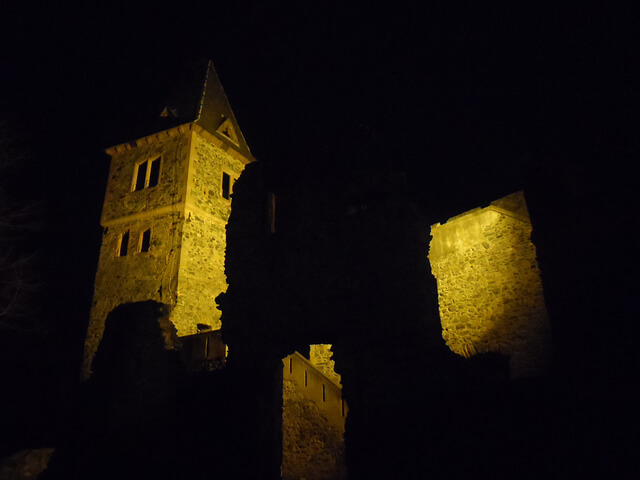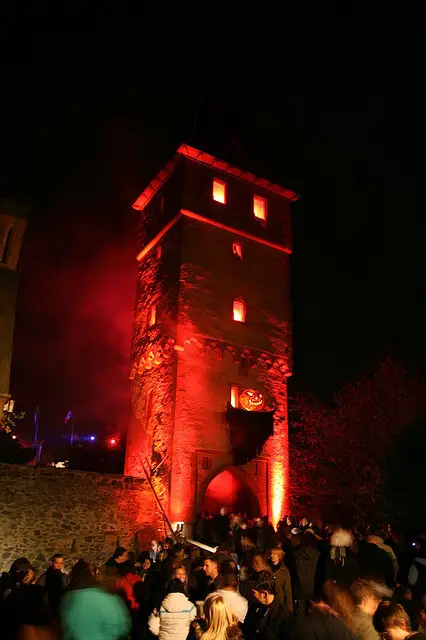Featured image by Óscar Palop.
A westerly wind rang through the intertwined tree branches and flickering torches scattered around the castle warmed the damp air, leaving an after-scent of petroleum behind. The rain still fell in small droplets onto the waterlogged ground, releasing the aroma of soil and grass. Underneath the head notes of air, earth, fire and water, the perfume of mulled wine, frying sausages and freshly baked pretzels from the food tents took over.

Castle Frankenstein. Photo by erikccooper.
During the day, Castle Frankenstein towers in ruins above the Rhine Plains which open out from Darmstadt and beyond. The castle-topped hill serves as a marker for the entrance to the Bergstrasse Valley in the mountainous Odenwald region in Western Germany, visited for its vineyards, hiking trails or as a good place to explore the German countryside by hire car.
The castle’s name recalls the iconic hammy horror films from the 70s, and especially on Halloween it delivered all expectations with its annual horror party.

The eerie lights of Halloween at Frankenstein’s Castle. Photo by Matt Drobnik.
The skeleton of Castle Frankenstein stands in piles of eclectic stone pieces made up of crumbling, jagged ruined walls or reconstructed battlements set with cement. The towers lean slightly to the left, crowned with a slate turret roof shaped to hard, triangular proportions.
At the entrance, we presented our tickets to a man hunched up with prosthetics and fake gore. His rat’s teeth pointed into fake plastic and shiny rubbery head played tribute to Count Orlock from Nosferatu.
“Willkommen auf Burg Frankenstein,“ he said. He forced his accent into exaggerated rolling rs and long vowels.
He waved us through the arched gate. The sound of laughter, chatter and even amused screams rang out. Flames and artificial lighting illuminated the flaking walls, painting it gory red, green and purple.
Within minutes my jeans soaked up the water and I had bits of mud splattered all over them. I had another party to go to afterwards and I already looked a mess. My flatmate chatted to her sister in accelerated German, which was too fast for me to follow. Instead I drunk in the staged displays of graveyards, spider webs, witches circles, coffins and all the clichés from the gothic novels and movies that I’ve grown up to love.

Photo by Matt Drobnik.
I stopped and glanced up at the tower. A dark red glow pulsated behind empty windows and the smell of burning torches helped to relieve the dampness. My flatmate and her sister walked on. I breathed in the damp air laced with smoke and surveyed my surroundings. I had passed the castle on the train a few times. It stood alone on the hilltop, and I conjured up this romantic ruin bathed in mystery in my head.
The Halloween festivities were fun, but the experience was inauthentic, a playful fake. I wanted to see Castle Frankenstein in its natural beauty, without the fake nails and theatrical make-up.
Rubbery hands reached over my jacket and grabbed me by the waist. I screamed and turned to an actor dressed as Frankenstein’s monster. He growled at me and I laughed. It was apt, considering the location.
I first heard about the Castle Frankenstein from my colleagues at the GSI, a laboratory just outside Darmstadt. In my past life I worked at a particle accelerator as a nuclear physicist, so I guess it was only natural I developed a curiosity for the “men who play God”.
It seemed that Geneva and Darmstadt had more in common than just a particle accelerator, and local folklore cites a firm connection between the Castle and the book. Castle Frankenstein was built in the 13th century, and predates the famous novel by five centuries.
On first impression, the connection between the castle and gothic novel appears purely coincidental. Mary Shelley wrote Frankenstein as a challenge set by Lord Byron, in which she had to write a horror story. In this particular instance, the mad scientist and the book’s title role is said to have spawned from a nightmare.
My life as a scientist was less interesting than sewing together dead body parts in the hope of electrocuting them back into life. I found myself stuck in a claustrophobic control room with lights flashing round me in multiple colours at 4 a.m. in heart of the lab complex. The numbers ticked on the sensors, and the gamma ray spectra displayed the raw data and I had to check on it every hour to make sure everything was going smoothly on my nightshift. For me being a scientist meant reading numbers and filling out endless file sheets and logbooks, I didn’t get to reanimate any dead bodies or turn lead into gold. I was too tired to read up on physics so I killed time by researching about the Castle until the next check.
Behind Frankenstein, there was a man: Johann Konrad Dippel, a theologian, alchemist and physician. Born in Castle Frankenstein in the 17th century, Dippel’s legacy became mangled and twisted over the centuries, and as another man who liked to play God, the fame of Frankenstein from the novel only served to heighten the legend.

Johann Kondrad Dippel. Source Skara kommun.
Gossip over the centuries tells of Dippel’s gruesome research conducted deep in the castle’s prison, where he experimented with dismembered body parts in the search for new life. Some of the tales are absurd, such as Dippel’s use of nitro-glycerine that destroyed one of the castle’s towers – in a time when nitro-glycerine didn’t exist.
Dippel’s controversy expanded beyond his theological circles when his obsession with alchemy consumed his life. Even wandering the castle, behind the Halloween decorations, there was a chill in the air. It was easy to envision Dippel strolling the grounds, now overgrown with shrubs and ivy scaling the walls, into the flat topped castle tower that served as the “Tower of Terror,” concocting potions on a worm-eaten wooden table lined with a alchemical symbols. Dippel created a tincture called “Dippel’s Oil,” his own version of the alchemist’s “Elixir of Life.”
Stories of soul transference spread across Germany like a disease and contaminated the history books with tales of “gruesome” experiments at Castle Frankenstein. Soul transference became common practice between 17th century alchemists, inspiring Dippel to write about it in his theological and alchemical writings. His experimentation on dead animals, meticulous study on anatomy and dissection was no secret, and even his thesis “Maladies and remedies of the life and flesh,” described his Elixir of Life, “Dippel’s Oil” as the means to exorcise demons. Dippel’s Oil was a potion made out of animal flesh and bones.
Later in his life, Dippel moved away from the Castle Frankenstein close to Wittgenstein, Germany, where Dippel experiments reached an obsessive level. Accusations from the local vicar charged him with grave robbing and experimentation on corpses – just like Victor Frankenstein in Shelley’s novel.
The connection between Castle Frankenstein, Johann Konrad Dippel and Mary Shelley’s magnum opus is controversial and purely speculative. Whether the author of Frankenstein ever came to Darmstadt or climbed the serpentine path up to the castle remains unproven, but the story and legends surrounding Viktor Frankenstein and Johann Konrad Dippel draw so many parallels that’s impossible to ignore.

Performance at the Frankenstein Halloween Party. Photo by Matt Drobnik.
As the rain spat onto the torches and bounced off the jagged walls of the castle at midnight, it was like a signal from Dippel that it was time to go. With my jeans soaked up to my knee, my boots coloured brown with mud we trudged towards the car and drove away. I looked back to the mountain, the thunder and lightning flashing in the distance creating a gothic backdrop behind the infamous Castle Frankenstein.
The castle may lie in ruins, but the legend of Frankenstein and Dippel, the tale of the men who played god, will never die.

